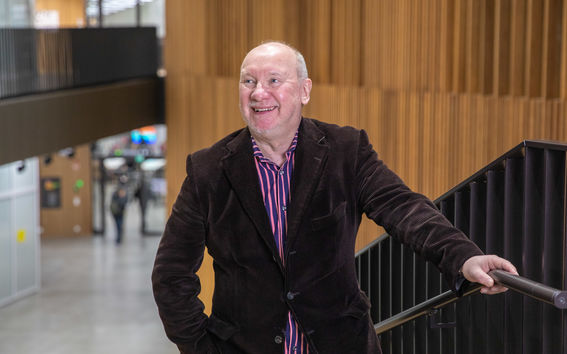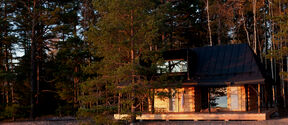Design is the mission of life for Eero Miettinen

How did you become a designer?
Well, it partly runs in the family, but I have always been drawing, so I decided to apply to the drawing school Ateneum. But since the line of graphic design was already full, I ended up studying technical design as a major. I, therefore, came to the industry somewhat accidentally, yet it felt like home from the beginning. I had always been drawing all kinds of vehicles, and I soon realised it’s a place where I could do just that.
For my thesis I designed a multipurpose vehicle. Before graduating, I started to work at Sisu Auto drawing trucks, which I did for five years. After that, I designed cars at Saab Valmet's car factory in Uusikaupunki and during that time, I built a design organisation for the company. However, the best part was designing cars. Among other things, I was able to design convertibles, which was the hottest thing in the industry at that time, and our company had cutting-edge expertise in convertible technology.
I worked on vehicles for a total of twenty years. Both jobs were extremely educational - they were like my high school for this profession so, there is some coincidence in getting into the industry, but at the same time, I have been purposefully following my own interest and a strong vocation.
After designing cars, you worked for a long time at Nokia. What was it like?
When I started at Nokia in 1998, the company and the industry were in a boom and I got to learn a whole new field and industry. The working environment was very international and the scale of all activities was global. As a Chief Designer, I built a global design organisation. My job was to bring together designers from all across the company and combine design activities, which later became Nokia Design. Although the scale was enormous, the same laws in design applied there too.
My time at Nokia was fabulous. Everything that we did was done for the first time in world history. We really felt like we were creating a better world: first, we got the Finns and then the whole world to communicate with each other, regardless of time and place. It all changed the world so much and in such a short time that it felt great.
Many years went by in a perfect state of happiness. It was interesting to see how it also fueled creativity - it was a strong positive twist. Nokia's success was certainly based on a positive and encouraging atmosphere and what was most crucial there was that the team really melded together.
Designer Eero MiettinenThe teaching experience has been invaluable since it helps one to follow the times. One cannot develop at the rate that students develop."
All along, you have also been teaching design, why?
Alongside working, I have been teaching design at the University of Art and Design Helsinki and then at Aalto University. Together with Kalevi Ekman, we gave the first course in industrial design for engineering students in the 1990s.
The teaching experience has been invaluable since it helps one to follow the times. One cannot develop at the rate that students develop. The course is completely new each year, and they all have their own 'thing' that one is forced to learn but alongside of this, we as teachers need to stay ahead of the students.
As a designer, you always have to understand the context where you act. You must have an understanding of what factors influence the design and what influence design can have. I've always tried to tell the students that this work has an opportunity to influence in many ways. The designer must be able to do their job well but it is a very subtle task, position and responsibility.
What does design mean to you?
It means better quality of life, and the pleasure of making objects, services and applications work. Design is a feature that cannot be turned off; it always follows along. It's really like a life’s mission. I tend to think of every item that I pick up, whether it's good or bad design, and how it could be designed better. I guess I'll never get rid of this.
On the other hand, there are so many horrible things in our built environment that designers will have a lot of work to do. And I do not mean creating new stuff, but rather how to design things better. A better connection between built and unbuilt environments is important, and there design plays a significant and responsible role.
Over the past ten years, the design and design-understanding have expanded tremendously, it is now ubiquitous. Service design is a good example: it is today everywhere and its significance and impact in the society are widely understood.
What are you going to do in the near future?
I am still drawing all the time, it's like breathing for me, and I still draw the same things. Maybe not the cars that much anymore, but boats and houses. I've gotten to design numerous cars, and now also a house aka our summer place, but I still have a boat on my list. If I could make the book I’ve planned, then I guess all the design stuff I’ve dreamed of would be done. They roll around in my thoughts all the time.
I’m also hoping that now there will be time to do something for myself and not just for others. The most important thing is definitely to take time for myself and my family, and learn a new, peaceful rhythm and enjoy the little everyday things.
Designer’s Destiny Seminar organised in honour of retiring professor in the Department of Design of Aalto University, Eero Miettinen, was held on January 23rd.
Read more news
Apply to be a guest professor or visiting researcher at the Université Grenoble Alpes
Unite! partner, Université Grenoble Alpes (UGA) has opened a call to host international professors and researchers for short stays.
Postdoctoral researcher Eloi Moliner makes history as a 5-time award winner
Eloi Moliner is one of the most decorated doctoral researchers in Aalto University's history – we would like to highlight his success and contributions to the field of audio signal processing
2 million euro donation to Aalto University's new multidisciplinary Bachelor’s programme – Donors: Matti Alahuhta, Sari Baldauf, Antti Herlin, and Jorma Ollila
Set to launch in autumn 2027, the multidisciplinary Bachelor's programme combines technology, business, arts, and design






